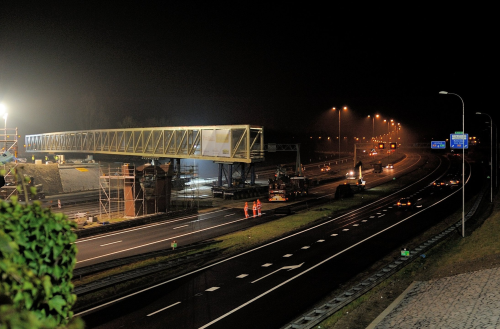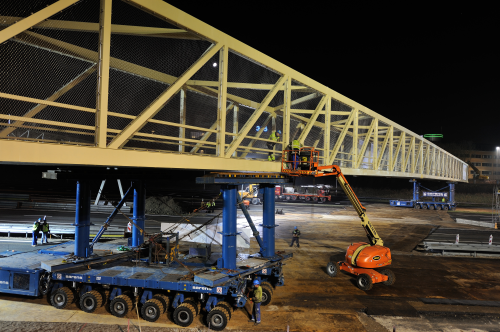

A time lapse video of the installation of the A27 bridge.
Part 1 of this article outlined the use of composite panels as formwork for the Uyllander Bridge across the Amsterdam-Rhine Canal in the Netherlands. In Part 2 we continue the story of the 140 m long traffic bridge near Lunetten across the A27 motorway in the Netherlands. It features a load-bearing composite deck bonded to its steel frame with a customised adhesive. Sounds like something you’d find in a sports car ...
A bridge like a sports car
The new bridge was needed because the old traffic bridge was going to be recommissioned as a railway bridge.
Initially a concrete bridge on seven supports was designed. But that was going to weigh 2650 tons. And there’s a plastic sheet at the intended location 6 m below the ground acting as a ground water dam, making a conventional steel or deep pile foundation to support 2650 tons impossible. A lightweight alternative was needed.
The solution was a steel truss viaduct on three supports. The architects (irs. Vegter b.i. in Leeuwarden, the Netherlands) already had experience with composites, working on the first European composites lifting bridge (in 2010 in Oosterwolde, the Netherlands). So they proposed a composite road deck, which had the advantage over a steel road deck of being vibration dampening and sound deadening. The cost turned out to be virtually the same.
“The longer the projected life span needs to be, the economical a composite solution will be,” Michiel Galema, director finance and market of composites bridge and lock gate builder FiberCore Europe comments as a general rule of thumb. Wood was no option because a life span of 100 years and low maintenance for at least 50 years was required.
The final design consisted of just two steel trusses, 6.5 m apart and 5 m high, connected on the bottom by a GRP and polyurethane foam sandwich road deck and on the top by a triangulation frame to combat wind loads.
“We don’t make classical sandwiches but InfraCore®Inside road decks,” says Galema.
“This makes them capable of handling heavy traffic classes, where they have to be able to stand up to impacts and repetitive loads.”
| The Dutch Ministry of Waterways and Public Works was sceptical, since a composite road deck had never been employed in this way before. But eventually they accepted it. |
The whole structure comes in at about 400 tons (140 for the deck and 250 for the frame). And still, it can handle all traffic, from pedestrians to the heaviest weight class (60 tons). It has an eigenfrequency of 3 Hertz and adheres to human-induced vibration regulations.
The Dutch Ministry of Waterways and Public Works was sceptical, since a composite road deck had never been employed in this way before. But eventually they accepted it.
The lightweight construction allowed a lot of prefabrication. The deck elements were made by FiberCore Europe in 14 weeks while construction company Hillebrand made the trusses. On the building site, just next to the place where the bridge was going to be installed, all those prefabbed bits only had to be assembled.
The road deck was prefabricated in seven segments of 24.5 m x 6.2 m (the largest size possible for fabrication and transport). For each part, polyurethane foam and sheets of glass fibre matting were stacked and then vacuum infused with resin. The difference with 'classical sandwiches' is that the foam is alternated with glass fibre to form skins perpendicular to the direction of the traffic to guarantee the constructive integrity even if the foam perishes. And all internal corners are covered with continuous matting to ensure long term high impact resistance.
Tests were done to prove the stress levels wouldn’t cause fatigue. The top of the sandwich is an epoxy bonded road surface and the bottom a gel-coat (for aesthetic reasons). The only maintenance needed is hosing it down to prevent moss growth and, if necessary, fixing the road surface.
In order to prevent stress due to thermal expansion, the fibre composition was chosen so the sandwich’s thermal expansion coefficient would match the one of steel.
On the building site, the seven segments were connected to form one stiff slab. Movement and gaps between the steel frame and the composite sandwich would be unacceptable because then moisture could come in, causing the steel to corrode. So the composite floor was inserted into U-shapes on the bottom of the side trusses. The space between the U-shapes and the floor was injected with resin. With temperatures plummeting to nearly -15°C this was done in a tent to ensure the injection could take place at the required 10°C. As a precaution pins were added, driven from the top to the bottom through the U-shapes and the sandwich.
Once fully assembled the bridge was rolled into place with SPMTs (Self Propelled Modular Transporters). Cranes could have made the installation even quicker, but would have risked damaging the underground water dam sheet.
Next to the 4.5 m wide road there’s a raised sidewalk, lying like a composite lid on a gutter for cables, pipes and water drainage.
And even more composite bridge innovations
Although groundbreaking, the A27 bridge wasn’t the first bridge FiberCore have built using DSM resins. They’ve already built more than 150 composite bridges in Western Europe, the US and China, including a bridge that floats on water and a movable traffic bridge.
On March 10, 2012, they achieved another interesting milestone in the Dutch 'Eendragspolder': the first bridge using bio-composites. It features DSM's Synolite 7500-N-1, a high strength structural resin which is 50% based on renewable raw materials (corn). With easy vacuum infusion and great resistance to rainy climates it was especially developed for bridges and is currently being evaluated for other applications in building, construction and infrastructure.
Nonwovens specialist Lantor in Veenendaal is working on a flexible nonwoven for de-icing purposes, which can be easily laminated with both polyester and epoxy.
“We add a carbon like conductive additive to the nonwoven,” says Reinier Jansen, Lantor’s product manager composites group.
“Once it’s laminated it retains electrical resistance, creating heat when you put electricity through it.”
How did they come up with that?
“We already work with conductive additives for the electrical cable industry. The different layers in high voltage cables are separated by non-conductive, semi-conductive or fully conductive nonwovens.”
The innovation is to use those nonwovens for heat generation.
“And to make them suitable for composites, in which they’re impregnated with rather aggressive epoxy and polyester,” Jansen adds.
“We can work both at low voltages – below 100 V – and high (230 V). And we can reach about 2 kW/m2.”
It should be available for small scale applications like epoxy pipes (for which it was originally conceived) around now. That’s to cure the epoxy adhesives that will connect the pipes, at above 100°C temperature. Next year a larger scale version will be available which Lantor is developing for Utec, a Dutch company making composite side elements to embellish bridges. It’s to be used for de-icing those so snow build-up doesn’t all fall down in one chunk. It might also be suitable for composite road decks, to prevent (black) ice.
How to spread the word
All these examples illustrate the exciting new possibilities composites are bringing to bridge building. Unfortunately, their application is still hampered by the fact that many people in civil engineering aren’t aware of them yet.
| ... in the Netherlands composite bridges are fully accepted now ... we have 200 ... and counting. |
“That’s certainly true in the rest of Europe and the world,” Galema comments.
“But in the Netherlands composite bridges are fully accepted now. I don’t think there are many countries that have more than ten composite bridges. In the Netherlands we have 200 ... and counting.”
So why is the rest of Europe lagging behind in the acceptation of composites bridges? According to Ten Busschen, who is also the chairman of the VKCN (the Dutch Association of Plastic Composites) the current European Standards have a lot to do with that: “Fibre reinforced polymers have sort of missed the boat with those standards. Composites have many design codes in specific areas, like aviation, wind propellers, tanks and pipes. But in a general sense, especially in civil engineering, there is no European Standard, whereas wood, concrete, steel, aluminium and even brick and mortar do have them.”
So the Dutch composites industry, the VKCN and engineering firms like Royal Haskoning formed an initiative to get an official European Standard going. In the Netherlands, companies processing polymers for civil engineering currently use an industry recommendation, written in 2004: the CUR Recommendation 96 ‘Fibre-reinforced polymers in load-bearing structures in buildings and civil engineering works.’ The idea was to use that as a basis for a European Standard.
So the recommendation was revised and updated, put into a European standard form and then translated into English. The Dutch standardisation institute NEN are now introducing it into the European Committee for Standardisation.
This CUR Recommendation has procedures for quality control so things like raw materials, resin mix, layer setup and processing conditions are as specified in the design. And it regulates the material properties and safety factors to use. It also offers the option of using project specific material properties instead of standard properties.
This means that if you perform tests on the actual material composites and constructions going into your project (as was done in the bridges covered in this article), you’re allowed smaller safety margins, leading to lighter and cheaper designs.
“The standard safety margins were already updated in the CUR revision to prevent unnecessarily high safety margins,” Ten Busschen adds.
Those safety margins had to be high initially, when composites were still new and exotic. Now that composites have proven themselves in so many projects and products, their safety margins can come down.
“People in England, Germany and Italy are actively working on a European standard as well,” Ten Busschen says.
“But I think the revised CUR Recommendation is the most comprehensive and concrete document. Once we have that European Standard, composites will have a much more equal position with other building materials.” ♦
This article was published in the November/December 2013 issue of Reinforced Plastics magazine.
The digital edition of Reinforced Plastics is distributed free of charge to readers who meet our qualifying criteria. You can apply to receive your free copy by completing the registration form.






